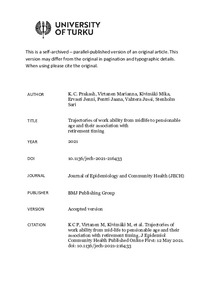Trajectories of work ability from mid-life to pensionable age and their association with retirement timing
Pentti Jaana; K. C. Prakash; Ervasti Jenni; Virtanen Marianna; Vahtera Jussi; Kivimäki Mika; Stenholm Sari
Trajectories of work ability from mid-life to pensionable age and their association with retirement timing
Pentti Jaana
K. C. Prakash
Ervasti Jenni
Virtanen Marianna
Vahtera Jussi
Kivimäki Mika
Stenholm Sari
Julkaisun pysyvä osoite on:
https://urn.fi/URN:NBN:fi-fe2021100750353
https://urn.fi/URN:NBN:fi-fe2021100750353
Tiivistelmä
BACKROUND: This study aimed to identify the trajectories of work ability over 16 years preceding the individual pensionable age and to examine the association with retirement timing.
METHODS: The study population consisted of 2612 public sector employees from the Finnish Retirement and Aging study and the Finnish Public Sector study. Participants were grouped into 'no-extension' (retired at the individual pensionable date or worked no longer than 6 months after that date) and 'extension' (worked more than 6 months after individual pensionable age). Trajectories of self-reported work ability score (0-10) in maximum of eight measurement points over 16 years preceding retirement were examined using the group-based latent trajectory analysis. Log-binomial regression was used to analyse the association between trajectory groups and extended employment.
RESULTS: Four stable ('Stable excellent', 7%; 'Stable high', 62%; 'Stable medium', 24%; 'Low', 4%) and one decreasing ('Declining', 3%) work ability trajectories were identified. After taking into account gender, age, occupational status, marital status and self-rated health, 'Stable excellent' trajectory was associated with a higher likelihood of extended employment compared with the 'Low' (risk ratio (RR) 2.38, 95% CI 1.21 to 4.68) and to the 'Declining' (RR 2.82, 95% CI 1.32 to 6.01) trajectories. There was no difference in retirement timing between 'Declining', 'Low' and 'Stable medium' trajectories.
CONCLUSION: Work ability remained relatively stable among majority of the participants over 16 years of follow-up. Stable excellent work ability from mid-life to late career was associated with higher likelihood of extending employment beyond individual pensionable age than those with low or declining work ability.
Kokoelmat
- Rinnakkaistallenteet [27094]
